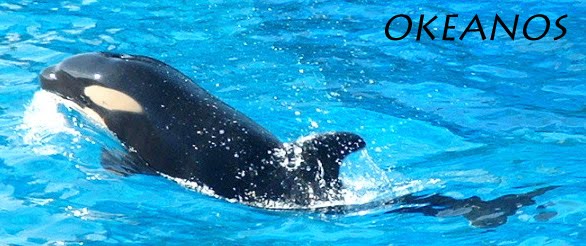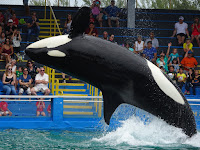The first killer
whale captured was in 1961. She was a female named Wanda, and lived for only
two days at Marineland of the Pacific, in California1. To date there
are approximately 59 orcas in captivity2, however the exact figure
is not known due to the lack of information on the orcas held in Russia and
China. Over the course of almost 60 years, 169 orcas have sadly lost their
lives in captivity1. In the early years of the industry, the orcas
in captivity had a short life span (on average 5 years), due to a lack of husbandry understanding.
The most common cause of death in captivity thus far has been pneumonia1,
making up a third of deaths. The captivity industry has been heavily opposed, particularly
after the release of Blackfish
(2013). Many ethical reasons for the opposition of captivity include the
confinement in small tanks, their broken up family units (both in the wild and
in captivity) and their reduced life spans3. The welfare of captive
orcas is also under question, the main issues being discussed below.
Stereotypies
Abnormal
repetitive behaviours, also known as stereotypies, are often regarded as an
indicator of poor welfare4. Stereotypies are poorly understand in
cetaceans, however circular swimming is often regarded as a stereotypical
behaviour5, in the same way as pacing in terrestrial animals. Other
stereotypies observed in captive orcas include: vomiting, head bobbing, comatose-like
states, self-mutilation, and tongue playing6. Many of the orcas have
also been observed as repetitively beaching themselves on the slide-out outside
of performance times, which I have personally observed Skyla doing at Loro
Parque in 2012. One of the more concerning abnormal behaviours, which can
affect their physical health is biting on the bars, gates, or tank walls. The
Loro Parque orcas, when they first arrived, were constantly stripping the paint
off the tank walls and ingesting it. This behaviour leads onto the next welfare issue that captive
orcas face.
Dental health
 Although
primarily a health issue this could also be considered a welfare issue. As the
orcas bite on the concrete walls of their tanks, they wear down their teeth.
Very few orcas in captivity have a full set of healthy teeth. As the teeth are
worn down, the pup cavities become exposed. The trainers then have to intervene
by either drilling their teeth or flushing the teeth to prevent infections7.
These procedures must be very stressful for the orcas.
Although
primarily a health issue this could also be considered a welfare issue. As the
orcas bite on the concrete walls of their tanks, they wear down their teeth.
Very few orcas in captivity have a full set of healthy teeth. As the teeth are
worn down, the pup cavities become exposed. The trainers then have to intervene
by either drilling their teeth or flushing the teeth to prevent infections7.
These procedures must be very stressful for the orcas.
Sun burn
This is an unusual
welfare issue that the orcas encounter. As the captive orcas spend most of
their life at the surface, they are more exposed to the sun’s UV rays than
their wild counterparts. As a result, trainers must apply black zinc oxide as a
sunscreen to the orcas, which is not necessary in the wild. Many of the
SeaWorld orcas are in states that receive a lot of sun, and the stadiums lack
appropriate shade to protect the orcas.
Disease/infections
Diseases and
infections are of course a natural part of life. Orcas in the wild will also
face these issues too. However, captivity has exposed some orcas to conditions
that they may not face in the wild. Two male orcas have died in captivity as a
result of disease transmission by mosquitoes. Kanduke* contracted St.Louis
encephalitis virus in SeaWorld Orlando and Taku* died of West Nile Virus at
SeaWorld San Antonio8. Kasatka* was also euthanized by vets after
suffering from a type of bacterial pneumonia, which caused many unpleasant
lesions on her skin9.
Along with
poor health caused by disease and infections, captive orcas also experience
injuries as a result of their confinement. Splash*, was a male orca at SeaWorld
San Diego, who received a jaw injury after having a seizure and smashing his
lower jaw on a metal gate. He didn’t die as a result of this injury, however he
had to have all of his bottom teeth removed and could never close it properly
again10. Nakai also received a horrific injury to his lower jaw in
2012. Nakai had a massive open wound that went down to the bone. SeaWorld tried
to pretend the injury was caused by Nakai catching himself on a gate, however
it is possible it was the result of an altercation between a tank mate, as
potential bite marks can be observed in photographs11. Fortunately
Nakai recovered from this.
Social stress
 Linking with
Nakai’s injury, which was caused by an altercation, social stress is a
prominent issue in captivity. The orcas are placed into unnatural groups. You
get orcas from different ocean’s kept together, who naturally feed on different
diets, and then experience family separations as orcas are transferred between
parks. The orcas of Loro Parque were a key example of an unnatural grouping as
Keto (aged 10), Tekoa (aged 5), Kohana (aged 3) and Skyla (aged 2) were
transported there. The group did not have an adult female present to keep them
in line, which goes against an orcas natural matriarchal society12. As
a result, the group is very dysfunctional. Social stress can lead to orcas
bullying each other, and the bullied orca is unable to escape as they would in
the wild. Many captive orcas can be seen with deep rake marks.
Linking with
Nakai’s injury, which was caused by an altercation, social stress is a
prominent issue in captivity. The orcas are placed into unnatural groups. You
get orcas from different ocean’s kept together, who naturally feed on different
diets, and then experience family separations as orcas are transferred between
parks. The orcas of Loro Parque were a key example of an unnatural grouping as
Keto (aged 10), Tekoa (aged 5), Kohana (aged 3) and Skyla (aged 2) were
transported there. The group did not have an adult female present to keep them
in line, which goes against an orcas natural matriarchal society12. As
a result, the group is very dysfunctional. Social stress can lead to orcas
bullying each other, and the bullied orca is unable to escape as they would in
the wild. Many captive orcas can be seen with deep rake marks.Solitary confinement
Sadly, there are currently three orcas in captivity that live without another orca companion - Lolita at Miami Seaqurium, Kshamenk at Mundo Marino and Kiska at Marineland Canada. Kiska is the most isolated of all, as she doesn't have any form of tank mate. Lolita and Kshamenk do in fact live with dolphin companions. Lolita has shockingly spent the last 40 years alone, whereas Kshamenk has been without a partner for 20 years and Kiska for almost 9 years. For a social species, this isolation must be incredibly lonely. It is a wonder how these individuals have lasted as long as they have, particularly Lolita.
Welfare improvements
Although I
don’t have the answers to easing all of the above listed welfare problems, I
have done some thinking on potential welfare improvements. For example, for the
orcas that live alone (Lolita, Kiska and Kshamenk), I think feeding them live
fish would be a good enrichment. I initially thought about it being used for
all orcas, but was unsure as to whether live fish for multiple orcas may cause
aggression problems if they fought over the food, and that’s why I thought it
would be best suited for solitary orcas. Alternatively, live fish could still
be fed to orcas in groups, but the orcas are sectioned off from each other (as
can be done at Marineland France).
I also read
an article by Law and Kitchener 201613 (Law was my lecturer at
Glasgow University), and they had suggested several environmental enrichment
options for captive orcas. Law had visited SeaWorld Orlando, and created these
ideas, however when I visited Orlando in 2018, I never saw any of his
suggestions in place. He said this could be due to the higher up people, rather
than the trainers, not willing to invest in the complex enrichment for the
orcas. However, if the higher ups could be convinced, these enrichment devices
could hopefully be applied to improve the welfare of the orcas.
In terms of
performing, I do not believe that making orcas perform entirely reduces their
welfare. As many orcas are inactive at the surface the majority of their day,
shows are a good change of pace. However some alterations could be to remove
the most unnatural tricks (like using the slideout) and the stadium music could
be changed. The music is often loud and blaring for the auditions, and so the
music could be changed to be more naturalistic, calmer, ocean sounds so as not
to disturb the orcas.
For the orcas that live alone, I am uncertain as how this should be addressed. The most obvious answer would be to move them to parks that have other orcas. However, having spent so long alone, entering a new social group could be incredibly stressful. The orcas that live with others aren't necessarily happier, because social hierarchies can cause conflict, and having the addition of new members can disturb the structure. For Lolita and Kshamenk who have managed this long, maybe keeping things as they are is the best solution, however Kiska's complete isolation really needs to be changed.
For the orcas that live alone, I am uncertain as how this should be addressed. The most obvious answer would be to move them to parks that have other orcas. However, having spent so long alone, entering a new social group could be incredibly stressful. The orcas that live with others aren't necessarily happier, because social hierarchies can cause conflict, and having the addition of new members can disturb the structure. For Lolita and Kshamenk who have managed this long, maybe keeping things as they are is the best solution, however Kiska's complete isolation really needs to be changed.
Regardless
of your views on captivity, we still may have orcas for another 30 years,
whilst this current generation dies out. Therefore it is important, that their
welfare needs are met as best as possible, so that they can live out the
remainder of their lives without further stress and illness.
References
4/ Broom DM 1991 Animal welfare:
concepts and measurement. Journal of Animal Science 69: 4167-4175








